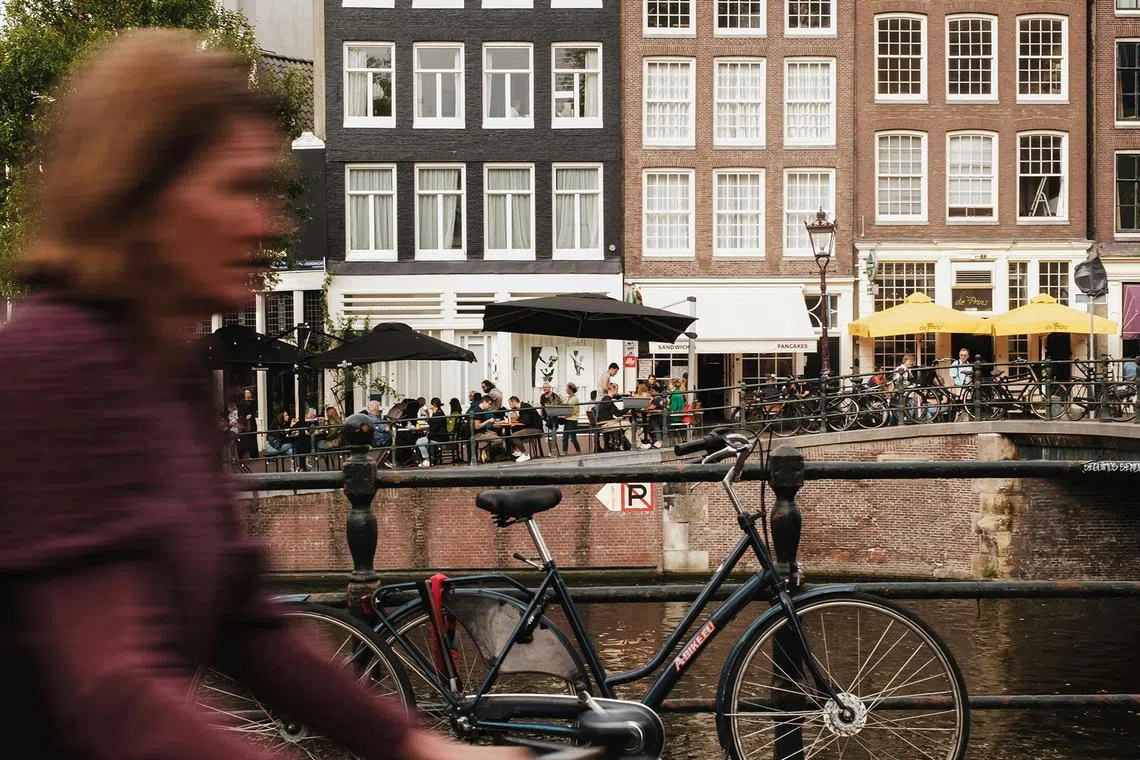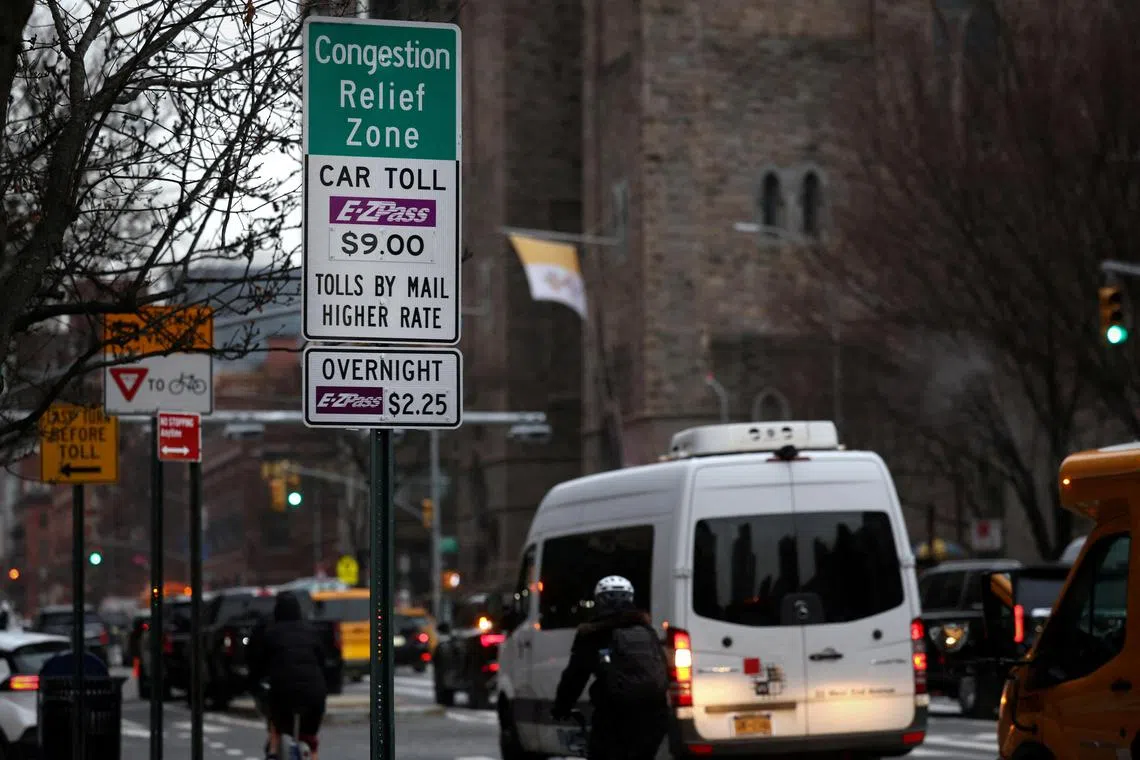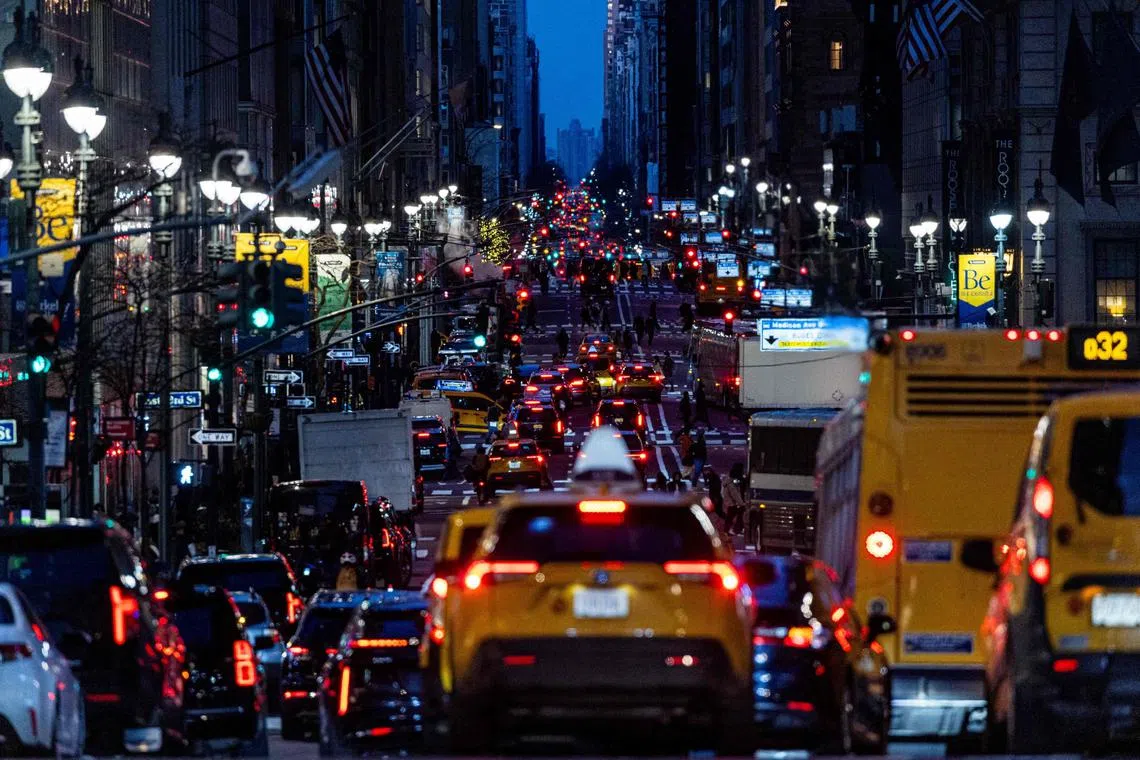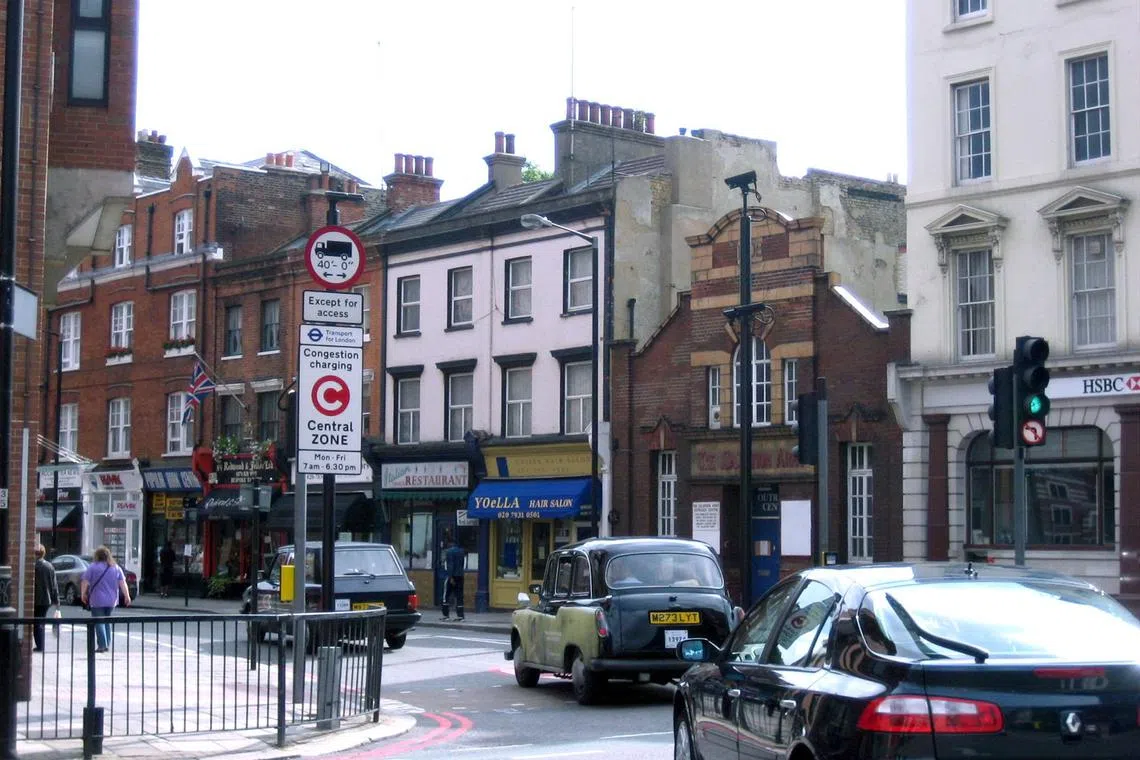Made In Singapore: ERP, the traffic solution pioneered by the Republic
Sign up now: Get ST's newsletters delivered to your inbox

In 1998, Singapore became the first in the world to implement an automated congestion pricing system to manage traffic.
ST PHOTO: GIN TAY
Follow topic:
SINGAPORE – Have you ever felt like you are spending days in a bad traffic jam? In some of the world’s most congested cities, you literally do.
In Dublin, Manila and Bengaluru, drivers lose over 100 hours a year to rush hour traffic.
Closer to home, Singapore motorists lost 63 hours a year to rush hour traffic in 2024, according to technology firm TomTom’s traffic index.
The question of how to manage the Republic’s traffic has a twofold solution: the introduction of the certificate of entitlement (COE) system in 1990 and the launch of congestion pricing on roads through the Area Licensing Scheme (ALS) in 1975.
While the COE remains uniquely Singaporean, congestion pricing has spread globally.
“Singapore was the pioneer in the implementation of road congestion pricing,” says Dr Phang Sock Yong, a professor of economics at Singapore Management University. “When Singapore implemented the ALS in 1975, it was the first city in the world to do so.”
Singapore was also the first to implement the evolved version of the ALS, now known as the automated Electronic Road Pricing (ERP) system, in 1998, ahead of cities such as British capital London and Swedish capital Stockholm.
As the idea gains traction across the world, cities from Jakarta to New York looking to address severe congestion have turned to Singapore as an example, with the city-state frequently appearing in reports and headlines discussing the policy’s impact.
Dr David Banks, a lecturer in the department of geography, planning and sustainability at the State University of New York at Albany, tells The Straits Times: “In nearly every report about NYC’s congestion pricing, there is a mention of Singapore, among other cities, as a means of showing that big cities have implemented congestion pricing for years.”
But what exactly makes the ERP so novel? And why has congestion pricing become a lightning rod for criticism from figures like US President Donald Trump?
Not all traffic solutions made equal
For as long as roads have existed, humans have pondered the question of how to manage excessive traffic.
Even in ancient Rome during 45BCE, the city banned most wheeled vehicles from entering the city’s centre during daylight hours to reduce congestion.
Today’s anti-congestion approaches have become more sophisticated.
One solution in European cities like Amsterdam is to disincentivise cars through steep parking charges, limited parking venues and the creation of park-and-ride facilities on city outskirts to promote the use of public transport.
Other cities – like Beijing in China and Mumbai in India – have at times adopted an odd-even car plate system, where only cars whose plates end or begin with an odd or even digit can drive on specific days.

European cities like Amsterdam disincentivise cars by implementing costly or limited parking options.
PHOTO: PEXELS
In contrast, Singapore opted for a different solution because of its unique circumstances.
With limited land and a rapidly growing population of cars, the Government introduced the ALS in 1975, which involved auxiliary police officers at gantries checking car windscreens for the presence of special paper licences that drivers had to purchase.
From 1961 to 1990, the total number of motor vehicles in Singapore increased from 117,936 to 542,352, according to data from the Land Transport Authority (LTA).
“The idea, however, did not originate in Singapore,” says Dr Phang.
Congestion pricing for subway rides was first proposed by Nobel laureate William Vickrey in the 1950s. And in 1964, the British Ministry of Transport published a report advocating road congestion pricing.
“With the successful transition from ALS to ERP in 1998, other cities were inspired to consider adoption of road pricing,” says Dr Phang, who adds that London and Stockholm followed with similar models in 2003 and 2006 respectively.
The ERP system works through gantries that combine a short-range wireless system communicating with an in-vehicle unit, charging drivers to drive through certain routes during peak hours. Gantries also have cameras to capture a vehicle’s rear licence plate to identify errant drivers.
These rates are reviewed once every quarter, with the aim of achieving an optimal speed on Singapore’s roads (around 20 to 30kmh on arterial roads and 45 to 65kmh on expressways). This charge acts as a financial disincentive that encourages the use of alternative routes or public transport during peak rush hours.
“Congestion pricing, if it’s done properly, can increase the operational capacity of the roadway,” says Dr Raymond Ong, associate professor at the National University of Singapore’s department of civil and environmental engineering.
This comes down to the science of traffic: Roads have a theoretical maximum throughput of cars that, once exceeded, brings traffic to a crawl. Reducing the number of cars present at any one time on a single road ultimately means that more cars can move through it because they are going faster.
Beyond alleviating congestion, the ERP also has positive spillover effects such as lowered environmental impact from vehicle emissions, as well as more pedestrian-friendly roads.
A bitter pill to swallow

A sign announcing that congestion pricing is in effect for drivers entering New York City’s central business district.
PHOTO: REUTERS
Despite its effectiveness, the introduction of congestion pricing is usually deeply unpopular, say experts.
For instance, New York City implemented congestion pricing in January to intense backlash. It levies a US$9 (S$12) toll for those entering the central business district, a fee reduced by 75 per cent at night.
In February, President Trump announced his intention to rescind the policy in New York.
Critics of the policy highlight how congestion pricing has a more disproportionate impact on less well-off drivers, and cite the need for better public transport alternatives.
For instance, prior to the policy’s implementation, the boroughs most against it were also the areas with the poorest public transport links.
Dr Banks notes that building the political will to implement the policy is difficult. “It is also technology-dependent, needing licence plate readers and transponders to work properly. These can be somewhat expensive to maintain and will of course fail in power outages,” he adds.
“Poor folks are forced to apply for a reduction in the toll for their own vehicle, and they might see higher prices if they take a cab or a ride-hailing service. Though, studies have shown that those regularly driving in the congestion relief zone are very well off.
“The congestion pricing system also has a carve-out for those with disabilities who have a hard time using the public transport system that is poorly outfitted to serve them.”
Despite the measure’s unpopularity, New York’s decision to implement congestion pricing is unsurprising. Out of all US urban areas measured by TomTom’s traffic index in 2024, New York had the worst congestion.
Drivers spend an average of 31 minutes to travel 10km in the city centre, and lose 98 hours a year to rush hour traffic, according to TomTom’s data.

According to TomTom’s traffic index data for 2024, New York City had the worst congestion of all US urban areas measured.
PHOTO: AFP
The city has a long history of attempting to introduce some form of congestion pricing, dating back to the early 20th century, which was also when the US started promoting car ownership.
For many Americans, car ownership is synonymous with freedom and success – translating to around 74 per cent of them owning or leasing a car today.
“There is a symbiotic relationship between the lack of transit, bike and pedestrian infrastructure, and views that anything other than car travel is not ‘realistic’,” says Dr Banks.
Since congestion pricing’s implementation, a Siena College poll found that 42 per cent of New York City residents want it to stay, while 35 per cent are in favour of President Trump’s attempts to quash it.
Dr Banks notes that this represents a 10 per cent jump in approval since it was implemented.
In response to criticism, New York’s governor Kathy Hochul has resisted attempts at rescinding the policy, arguing that money raised from charging tolls would underpin mass transit improvements in the city.
New York resident Alexander Hill, a 31-year-old software engineer, is hopeful that congestion pricing is here to stay. “As a driver, I think it’s been an overnight success. The streets have been noticeably less busy in Manhattan already.
“It’s only US$9, so it’s nothing compared with anything you could actually buy or do in Manhattan,” adds the former Singapore resident, who lived here from 2016 to 2017. “It makes sense that Singapore put into action strict but effective ideas like that decades before anyone else.”
Similar patterns of resistance can also be seen elsewhere.

While London successfully implemented congestion pricing, it was met with much initial opposition.
PHOTO: BLOOMBERG
Professor Georgina Santos, of Cardiff University’s school of geography and planning, says in the United Kingdom, London was able to introduce congestion pricing while Edinburgh and Manchester failed to do so.
The difference may be because these cities put their plans to a vote after a public consultation, while London pressed ahead after its consultations without a referendum.
“It is a very unpopular policy, but in London and Stockholm, people got used to it,” says Dr Santos, who notes that the policy survived three different mayors in the British capital.
“Another difference may have been that the situation in London was next to unbearable. Traffic speeds were those of horse-and-carriage 100 years earlier. London was getting to the point where traffic congestion was causing untold disruption,” she adds.
Meanwhile, Stockholm’s congestion tax uses a cordon-based system around its central area, with motorists paying a toll which fluctuates based on the time of day.
Vehicles are charged when they cross under a metal gantry, which detects a vehicle using a laser and uses cameras to capture the vehicle’s front and rear number plates.
Public opinion – which was once strongly negative – shifted in favour of the congestion tax due to a visible decrease in congestion after a seven-month trial. Some 53 per cent of Stockholm residents voted to keep the scheme permanently.
While Singapore’s ERP revenues go into a general fund, congestion pricing systems elsewhere are typically used to fund transport and infrastructure improvements, like extensions to Stockholm’s metro system.
Ultimately, compensation schemes, rebates and exemptions are key to dealing with the negative impacts of congestion pricing, says Dr Santos.
“No congestion charge can be implemented unless there is feasible, practical, affordable and reliable public transport,” she adds.
Why congestion pricing was made for Singapore
Singapore’s success with congestion pricing can be attributed to several factors that made it the perfect testing ground for such a policy.
The city-state’s small size and strong political will from a highly centralised government allowed for effective implementation of the ERP, says Dr Ong.
The Republic also invested heavily in public transport, providing a viable alternative to driving.
“Technology alone cannot improve congestion. It has to be part of an overall approach to enable a more efficient private transport system, along with public transport,” notes Dr Ong.
He adds that Singapore’s status as a city-state also made it uniquely positioned to implement comprehensive traffic management policies involving in-car devices for the ERP and the COE system, as “all our vehicles are controlled within our island”.
“If you asked me whether other cities could do it, the answer is no. Beijing, for example, could have cars from other states and provinces, and there’s no way to control that.”
And difficult conditions can stymie congestion pricing on roads. For example, although Jakarta’s local government has long discussed implementing a similar system, drivers in the Indonesian city say this vision remains elusive.

Jakarta residents say congestion pricing is unlikely due to the city’s lack of public transport and its many motorcycles.
PHOTO: PEXELS
Jakarta resident Farah Hafizhah, a 24-year-old consultant and motorist, says the Indonesian capital has a Ganjil-Genap (Odd-Even) system for road vehicles, meaning that only cars with odd- or even-numbered licence plates can go through the city’s main roads depending on the day.
The ERP is due for implementation later, but Ms Farah is pessimistic about its effectiveness. “In Singapore, this works because the public transport infrastructure is adequate and integrated. At the moment, I think Jakarta’s is nowhere near Singapore’s.
“We have loads of motorcycles on the roads,” she says. “And they are one of the reasons traffic is very congested in Jakarta.
“To introduce ERP to them will be another issue. They are immune to the Odd-Even policy, since the surveillance system is not advanced enough to catch them.”

London’s congestion pricing saw mixed results for traffic, but now represents over 5 per cent of Transport for London’s revenue in 2023/2024.
ST PHOTO: CYNTHIA LOW
Meanwhile, London’s congestion pricing, which was introduced in 2003 and is implemented as a daily licence scheme enforced through cameras and patrolling vans, has seen mixed results.
In a 2019 review of congestion pricing worldwide, University of Illinois Urbana-Champaign assistant professor Lewis Lehe writes that London’s congestion charge successfully reduced the number of cars entering its zone.
However, the travel speed improvements of around 20 per cent experienced in the first years returned to pre-charging levels by 2007, which Transport for London attributes to changes in the road network that reduced capacity.
Private-hire vehicles were also exempt from the charge until 2019, undermining its effectiveness.
That is not to say congestion pricing is not useful. In the 2023/2024 financial year, congestion pricing generated £345.9 million (S$598 million) in revenue, representing 5.2 per cent of Transport for London’s total revenues for that year.
The government body has argued that congestion pricing supports infrastructure improvements that would not have been available otherwise.
What next for ERP?

The majority of ERP gantries remain switched off, following the suspension of ERP in 2020 as part of circuit-breaker measures.
ST PHOTO: LIM YAOHUI
As Singapore enters the 27th year since the launch of the ERP system, it has to contend with a broader shift in attitudes towards cars that began during the Covid-19 pandemic.
The development of ERP 2.0, based on GPS (Global Positioning System), represents the next evolution in Singapore’s congestion pricing approach.
“That’s the main reason for ERP 2.0, so we can do more robust tracking of vehicles on the road, and to do more microscopic analysis of the level of congestion and speed,” says Dr Ong.
Although all new vehicles were fitted with the ERP 2.0 on-board unit from the first quarter of 2024, distance-based charging has yet to be implemented.
Owners of existing vehicles were notified from November 2024 to schedule the installation of their on-board unit.
After the transition period into the ERP 2.0 system is complete, today’s physical gantries will also become a thing of the past.
In November 2024, Minister for Transport Chee Hong Tat said in response to a parliamentary question that travel patterns have evolved since the Covid-19 pandemic, meaning that total vehicle mileage had fallen by around 6 per cent from 2019 to 2023.
According to the LTA, the average volume of daily traffic entering the city stood at 293,218 vehicles in 2023, the last year with available data. This figure is below the above-300,000 average figure recorded in the pre-pandemic years.
“We have also observed lower traffic demand in the CBD, and ERP gantries in the city cordon remain un-activated,” says Mr Chee.
Today, the majority of ERP gantries remain switched off, following the suspension of ERP in 2020 as part of circuit-breaker measures.
For motorists like video producer Daxa Angresh, 28, Singapore’s traffic policies make sense despite occasional complaints. “I drive regularly in Johor Bahru and the peak hours there are approximately five to six hours long and the jams go for many kilometres, sometimes back several highways. And that’s with a quarter of Singapore’s population density.”
Mr Vareck Ng, a 22-year-old student and advocate for cycling- and pedestrian-friendly urban planning, suggests Singapore still has room for improvement.
“I think Singapore is making moves towards being an increasingly car-free place, but there’s a lot of work to be done in terms of city design.”
He says Singapore’s current car policies can create a sunk-cost fallacy where people might want to drive more to get the most use out of their vehicles.

Advocates for pedestrian-friendly urban planning cite Amsterdam as an example of a mostly car-free city.
PHOTO: PEXELS
“The Netherlands has no COE, yet people willingly cycle and take public transport because their trains are faster than driving on expressways, and in the city core, public transport and cycling are prioritised,” he says.
“Public transport is not just seen as an option for people priced out of car travel, but also as a premium mode of getting around.”
This is the first instalment of Made In Singapore, a series examining the Singaporean roots of global creations.
Teo Kai Xiang is a journalist at The Straits Times’ Life desk, covering emerging trends, unusual subcultures and lesser-known facets of life in Singapore.


